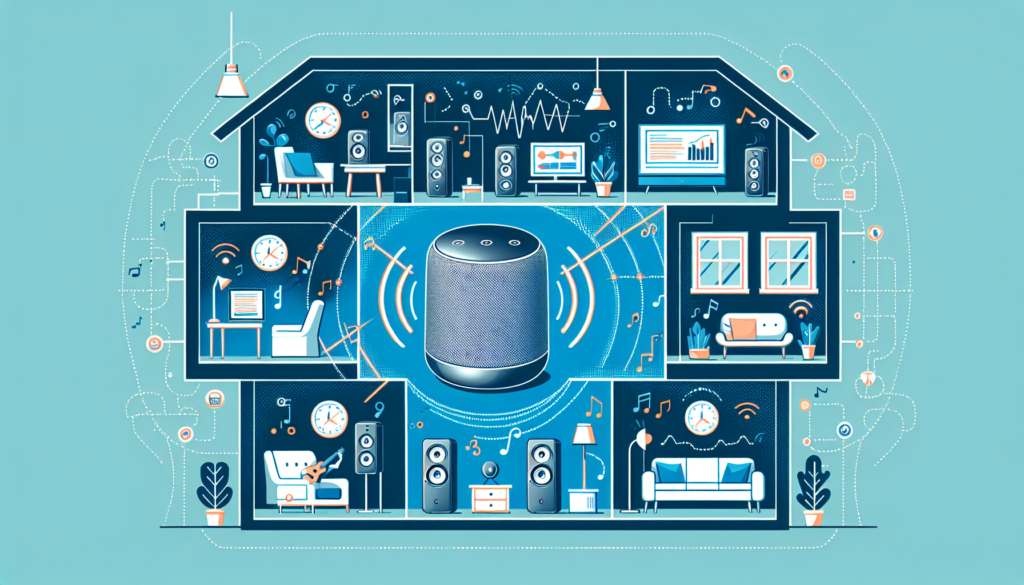If you’re someone who loves music and enjoys having it play throughout your entire home, then creating a whole-home audio system with multiple smart speakers is the perfect solution for you. With this setup, you can have your favorite tunes follow you from room to room, creating a seamless listening experience. But how exactly can you make this happen? In this article, we’ll guide you through the simple steps of connecting multiple smart speakers to create your dream whole-home audio system, bringing the joy of music to every corner of your home. So get ready to immerse yourself in a world of sound and let the music transport you wherever you go.

Choosing the Right Smart Speakers
When it comes to creating a whole-home audio system with multiple smart speakers, the first step is choosing the right speakers. Consider the speaker brand and compatibility with your preferred smart home ecosystem. Some popular options include Google Home, Amazon Echo, and Apple HomePod. Make sure that the smart speakers you choose are compatible with the voice assistants or platforms you plan to use.
In addition to compatibility, it is crucial to assess the audio quality and features of the smart speakers. Look for speakers that offer good sound quality, especially if you are an audiophile or someone who values high-fidelity audio. Features such as built-in voice control, multi-room audio capabilities, and smart home integration can also enhance your whole-home audio experience.
Lastly, don’t forget to evaluate the connectivity options of the smart speakers. Ensure that they have the necessary connectivity options to suit your needs, such as Bluetooth, Wi-Fi, and auxiliary inputs. This will allow you to connect and control the speakers effortlessly.
Setting Up the Smart Speakers
After choosing the right smart speakers for your whole-home audio system, it’s time to set them up. The first step is to decide on the placement of speakers in different rooms. Consider the layout of your home and the areas where you want to enjoy music. Ideally, place the speakers in a centralized location in each room to ensure optimal sound distribution.
Once you have determined the speaker placement, connect the speakers to a power source. Most smart speakers come with a power adapter that needs to be plugged into a wall outlet. Ensure that the speakers are placed near power outlets for convenience.
Next, connect the speakers to your home Wi-Fi network. This step may vary depending on the brand and model of the speakers. Typically, you will need to open the speaker’s app or control panel and follow the on-screen instructions to connect the speakers to your Wi-Fi network. Make sure to provide the required network credentials, such as the Wi-Fi network name (SSID) and password.

Creating a Multi-Room Group
One of the key advantages of having a whole-home audio system is the ability to create a multi-room group. With a multi-room group, you can play the same audio in multiple rooms simultaneously, immersing your entire home in music.
To create a multi-room group, open the speaker’s app or control panel and navigate to the multi-room audio settings. The location and naming of this option may vary depending on the brand and model of the speakers. Once you have located the multi-room audio settings, follow the instructions provided to create a multi-room group.
The process usually involves selecting the speakers you want to include in the group and assigning a group name. After setting up the multi-room group, you can easily control it through the speaker’s app or voice commands.
Syncing and Controlling Audio
Once you have set up the multi-room group, it’s time to sync and control the audio across all connected speakers. By accessing the audio settings on your smart speaker app, you can specify the multi-room group as the audio output.
When playing audio, select the multi-room group as the desired output in the app. This will ensure that the audio is played simultaneously on all the speakers in the group, providing a seamless audio experience throughout your home. Additionally, you can control the volume and playback settings across all connected speakers directly from the app.

Expanding the Whole-Home Audio System
If you want to expand your whole-home audio system to additional rooms or areas, adding more smart speakers is the way to go. When adding new speakers, ensure proper placement and spacing for optimal audio quality. Consider the acoustics of each room and strategically position the speakers to achieve the best sound balance.
Once the new speakers are in place, you will need to configure them to join the existing multi-room system. Follow the manufacturer’s instructions, usually provided through the app or control panel, to add the new speakers to the multi-room group. This will allow them to synchronize with the other speakers and be controlled collectively.
Troubleshooting and Fine-tuning
In any technological setup, troubleshooting and fine-tuning may be required to ensure smooth operation. If you encounter any issues with the whole-home audio system, there are a few steps you can take to resolve them.
Firstly, ensure that all the speakers are connected to the same network. Inconsistent network connections can cause audio synchronization problems. Check the Wi-Fi settings on each speaker and make sure they are connected to the correct network.
Secondly, check for firmware updates for your speakers. Manufacturers often release firmware updates to improve performance and address any bugs or compatibility issues. Updating the firmware can help resolve any software-related problems you may encounter.
Lastly, adjust the audio settings for each room as needed. Different rooms may have varying acoustics, and fine-tuning the audio settings can optimize the sound quality. Experiment with settings such as equalization, bass, and treble to achieve the desired audio experience in each room.

Voice Control and Additional Features
Integrating your smart speakers with voice assistants like Siri or Alexa can significantly enhance your whole-home audio system. This allows you to control the speakers and the overall audio system through voice commands. Simply ask the voice assistant to play music in a specific room or group, adjust the volume, or skip tracks.
Additionally, smart speakers often come with additional features like smart home automation. You can control various smart devices in your home, such as lights, thermostats, and security systems, using your smart speakers. Explore these features to make your whole-home audio system an integral part of your smart home ecosystem.
Multi-Room Audio on Different Platforms
The process of setting up multi-room audio may vary depending on the platform you are using. Here are some specific instructions for popular platforms:
Using Google Home or Chromecast for multi-room audio:
- Ensure that all your Google Home or Chromecast devices are set up and connected to the same Wi-Fi network.
- Open the Google Home app on your smartphone or tablet.
- Tap on the “+” icon to add a new device.
- Follow the on-screen instructions to set up your additional devices.
- Once the devices are set up, tap on the Devices tab in the Google Home app.
- Select the devices you want to include in the multi-room group.
- Tap on the group icon at the bottom of the screen and create a new speaker group.
- Assign a name to the group and save the settings.
Setting up multi-room audio with Amazon Echo devices:
- Ensure that all your Amazon Echo devices are set up and connected to the same Wi-Fi network.
- Open the Alexa app on your smartphone or tablet.
- Tap on the Devices tab at the bottom of the screen.
- Tap on the “+” icon to add a new device.
- Follow the on-screen instructions to set up your additional devices.
- Once the devices are set up, go to the Settings tab in the Alexa app.
- Tap on the Audio Groups option and select Multi-Room Music.
- Tap on Create Group and select the devices you want to include in the group.
- Assign a name to the group and save the settings.
Exploring Apple’s AirPlay 2 for multi-room audio:
- Ensure that all AirPlay 2-compatible devices, such as Apple HomePod or Apple TV, are set up and connected to the same Wi-Fi network.
- Open the Home app on your iPhone or iPad.
- Tap on the “+” icon to add a new accessory.
- Follow the on-screen instructions to set up your additional devices.
- Once the devices are set up, go to the Rooms tab in the Home app.
- Long-press on a room and tap on Details.
- Tap on Create Stereo Pair or Create Group.
- Select the devices you want to include in the group.
- Assign a name to the group and save the settings.

Best Practices for Whole-Home Audio System
To ensure the best audio experience in your whole-home audio system, consider the following best practices:
- Consider the acoustics and layout of your home when placing speakers. Experiment with their placement to achieve optimal sound distribution.
- Test and adjust speaker placement. Fine-tuning the position of speakers can make a noticeable difference in the audio quality.
- Ensure a stable and reliable Wi-Fi network connection. A weak or fluctuating internet connection can impact the synchronization and performance of the whole-home audio system.
By following these best practices, you can make the most of your whole-home audio system and enjoy immersive sound throughout your home.
Conclusion
Creating a whole-home audio system with multiple smart speakers can transform your living spaces into a haven of music. By carefully choosing the right speakers, setting them up correctly, and creating a multi-room group, you can enjoy synchronized audio throughout your home.
Remember to sync and control the audio across all connected speakers, expand your system as desired, troubleshoot any issues that arise, and explore the additional features and voice control capabilities of your smart speakers.
With a stable Wi-Fi network connection, proper speaker placement, and optimization of audio settings, you can create an outstanding whole-home audio system that elevates your music listening experience to new heights. So go ahead, immerse yourself in the world of whole-home audio and enjoy your favorite tunes in every room.










